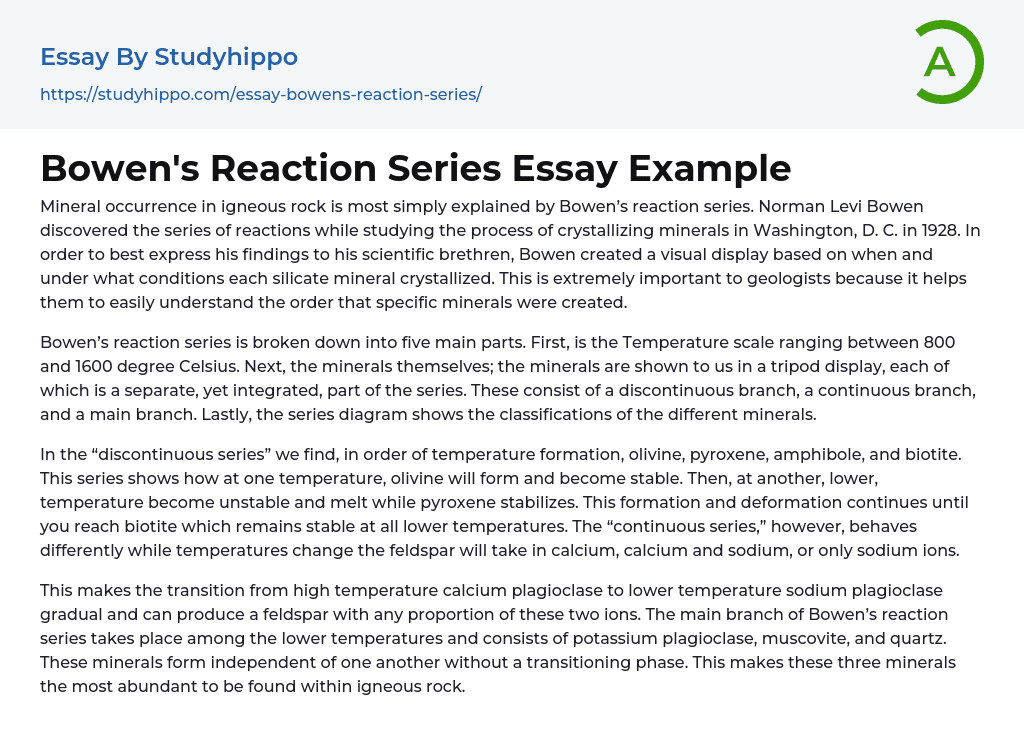Mineral occurrence in igneous rock is most simply explained by Bowen’s reaction series. Norman Levi Bowen discovered the series of reactions while studying the process of crystallizing minerals in Washington, D. C. in 1928. In order to best express his findings to his scientific brethren, Bowen created a visual display based on when and under what conditions each silicate mineral crystallized. This is extremely important to geologists because it helps them to easily understand the order that specific minerals were created.
Bowen’s reaction series is broken down into five main parts. First, is the Temperature scale ranging between 800 and 1600 degree Celsius. Next, the minerals themselves; the minerals are shown to us in a tripod display, each of which is a separate, yet integrated, part of the series. These consist of a discontinuous branch, a continuous branch, and a main branch
.... Lastly, the series diagram shows the classifications of the different minerals.
In the “discontinuous series” we find, in order of temperature formation, olivine, pyroxene, amphibole, and biotite. This series shows how at one temperature, olivine will form and become stable. Then, at another, lower, temperature become unstable and melt while pyroxene stabilizes. This formation and deformation continues until you reach biotite which remains stable at all lower temperatures. The “continuous series,” however, behaves differently while temperatures change the feldspar will take in calcium, calcium and sodium, or only sodium ions.
This makes the transition from high temperature calcium plagioclase to lower temperature sodium plagioclase gradual and can produce a feldspar with any proportion of these two ions. The main branch of Bowen’s reaction series takes place among th
lower temperatures and consists of potassium plagioclase, muscovite, and quartz. These minerals form independent of one another without a transitioning phase. This makes these three minerals the most abundant to be found within igneous rock.
- Organic Chemistry essays
- Acid essays
- Calcium essays
- Chemical Bond essays
- Chemical Reaction essays
- Chromatography essays
- Ethanol essays
- Hydrogen essays
- Periodic Table essays
- Titration essays
- Chemical reactions essays
- Osmosis essays
- Carbohydrate essays
- Carbon essays
- Ph essays
- Diffusion essays
- Copper essays
- Salt essays
- Concentration essays
- Sodium essays
- Distillation essays
- Amylase essays
- Magnesium essays
- Acid Rain essays
- Oxygen essays
- Atmosphere essays
- Coral Reef essays
- Desert essays
- Earth essays
- Ocean essays
- Lake essays
- Sea essays
- Biodiversity essays
- Natural Environment essays
- Forest essays
- Soil essays
- Water essays
- Rainbow essays
- Ecosystem essays
- Volcano essays
- Wind essays
- Forestry essays
- Bottled Water essays
- United States Postal Service essays
- U.S. State essays
- U.S. Securities And Exchange Commission essays
- United Parcel Service essays
- San francisco essays
- Tennessee essays
- The Us Constitution essays




